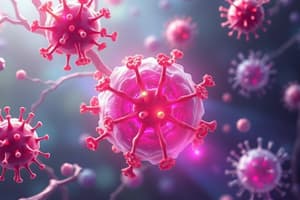Podcast
Questions and Answers
What can cause biologic effects of complement activation?
What can cause biologic effects of complement activation?
- Nutritional deficiencies
- Persistent infection or autoantibodies (correct)
- Environmental toxins
- Genetic mutations only
What effect does complement activation have on disease pathology?
What effect does complement activation have on disease pathology?
- It has no significant effects
- It may contribute to inflammation and lysis (correct)
- It exclusively promotes healing
- It inhibits the inflammatory response
What is a common result of elevated complement levels?
What is a common result of elevated complement levels?
- Specific diagnosis of infections
- Improved tissue regeneration
- Decreased immune response
- Association with inflammatory conditions (correct)
Which of the following best explains decreased complement levels?
Which of the following best explains decreased complement levels?
What role does the C1 inhibitor (C1INH) play in the complement system?
What role does the C1 inhibitor (C1INH) play in the complement system?
Which component is targeted by MAC inhibitors?
Which component is targeted by MAC inhibitors?
Deficiencies in complement are linked to which of the following?
Deficiencies in complement are linked to which of the following?
What is the function of complement receptor type I (CRI or CD35)?
What is the function of complement receptor type I (CRI or CD35)?
What is the primary function of the complement system in relation to pathogens?
What is the primary function of the complement system in relation to pathogens?
Which of the following correctly describes the activation of complement components?
Which of the following correctly describes the activation of complement components?
Which component of the complement system is synthesized mainly by hepatocytes?
Which component of the complement system is synthesized mainly by hepatocytes?
What are the three main physiological activities of the complement system?
What are the three main physiological activities of the complement system?
Which complement pathway is independent of mannose?
Which complement pathway is independent of mannose?
What happens to complement components once they are activated?
What happens to complement components once they are activated?
Which statement about the complement system is false?
Which statement about the complement system is false?
Which of the following groups of components is specifically involved in the classical pathway of complement activation?
Which of the following groups of components is specifically involved in the classical pathway of complement activation?
What is the function of C3 convertase?
What is the function of C3 convertase?
Which factor is involved in the formation of the C5 convertase?
Which factor is involved in the formation of the C5 convertase?
What role does properidin play in the complement system?
What role does properidin play in the complement system?
What is the result of C3 and C5 complement activation in the immune response?
What is the result of C3 and C5 complement activation in the immune response?
In the presence of pathogen components like LPS, what happens to Factor H?
In the presence of pathogen components like LPS, what happens to Factor H?
What three main physiological activities are associated with the complement system?
What three main physiological activities are associated with the complement system?
What stimulates mast cells and basophils during complement activation?
What stimulates mast cells and basophils during complement activation?
Which of the following is NOT a component of the classical pathway of complement activation?
Which of the following is NOT a component of the classical pathway of complement activation?
What happens if complement complexes accumulate in tissues?
What happens if complement complexes accumulate in tissues?
Flashcards are hidden until you start studying
Study Notes
Complement Proteins
- Over 20 serum glycoproteins
- Synthesized by hepatocytes (except C1)
- Important for killing pathogens, recruiting inflammatory cells, opsonizing pathogens, and clearing immune complexes
- Many circulate as proenzymes (inactive enzymes) that require proteolytic cleavage for activation.
- Once activated, components catalyze the next step of the pathway.
- Activated components remain active for a short time.
Functions of the Complement System
- Three main functions
- Host defense against infection
- Interface between innate and adaptive immunity
- Disposal of waste
Complement System Activation Pathways
- Three main pathways
- Classical
- Alternative
- Mannose-binding lectin
Classical Pathway
- Initiated by antigen-antibody complexes or certain pathogen components
- C1q binds antigen-antibody complexes or pathogen surface
- C1r and C1s are activated.
- C1s cleaves C4, generating C4a and C4b
- C2 binds C4b and is cleaved by C1s, generating C2a and C2b
- C4b2a complex forms the classical pathway C3 convertase.
- C3 convertase cleaves C3 to C3a and C3b.
- C4b2a3b complex forms the classical pathway C5 convertase.
- C5 convertase cleaves C5 resulting in C5a and C5b.
C1q
- Binds to antigen-antibody complexes and pathogen surfaces.
C1r & C1s
- Cleave C4 and activate complement by triggering the classical cascade.
C4
- Cleaved by C1s.
C2
- Cleaved by C1s after binding to C4b
Properidin
- Stabilizes the alternative pathway C3 convertase (C3bBb).
Results of Complement Activation
- C3a, C4a, C5a activate mast cells and basophils.
- C5a activates neutrophils and monocytes.
- C5b-9 forms the membrane attack complex (MAC), which can lyse cells.
Complement Activation and Disease
- Elevated complement levels can be associated with inflammatory conditions, trauma, and acute illness.
- Decreased complement levels can be associated with excessive complement activation, complement consumption, or genetic deficiencies in specific complement components.
Complement Regulation
- Control mechanisms ensure complement system activation is regulated and does not cause excessive damage:
- C1 inhibitor (C1INH): blocks C1 activity
- Anaphylatoxin inactivator: inactivates C4a, C3a, and C5a.
- MAC inhibitors: inactivate C5b-7.
- Complement receptor type I (CRI or CD35): inactivates C4b and C3b.
Studying That Suits You
Use AI to generate personalized quizzes and flashcards to suit your learning preferences.




